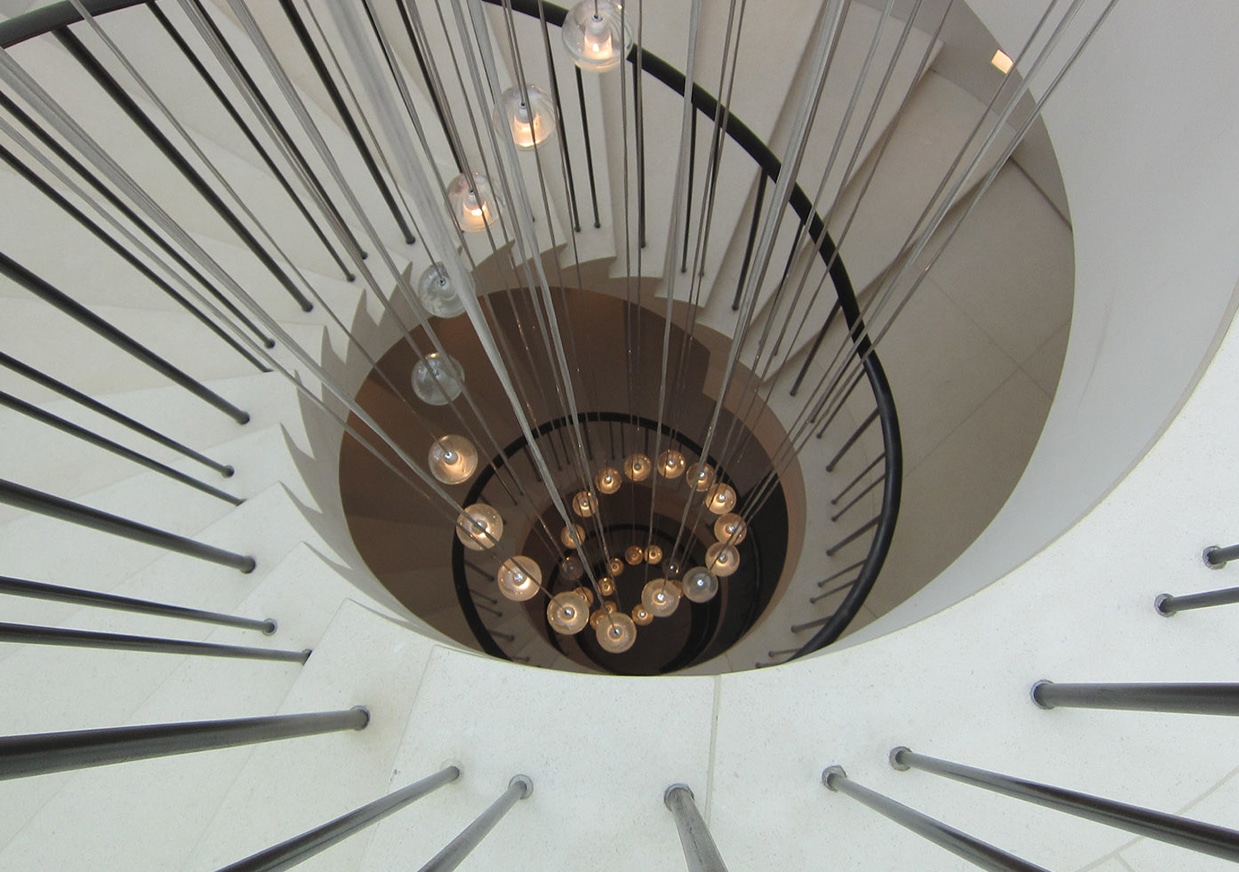The three types of natural stone staircases: best early-stage advice and planning considerations
Ken Jones, Director at AF Jones Stone Interiors is also a structural engineer and an expert on natural stone staircase construction. Here, he talks through the different kinds of stone staircase options available to architects and main contractors, and what considerations in the design and build process these staircases should be considered: from cantilevered and clad stone staircases through to the more sophisticated post-tensioned staircases.
Exploring the Art of Natural Stone Staircases: From Concept to Completion
When embarking on the design of a main staircase, collaboration between stonemasons and architectural partners starts with a pivotal decision: choosing the type of staircase. This foundational choice, setting the direction for the entire project, centres around determining whether the staircase will be clad, solid, or feature a more specific design such as a cantilever or post-tension structure. Each option offers unique advantages and contributes distinct aesthetic qualities, making the initial selection process integral to realising the desired architectural outcome.
Understanding the Options for Stone Staircases
- Clad Staircases: These staircases involve treads and risers affixed to an underlying structure, such as concrete, allowing for versatility in design while showcasing the natural stone’s beauty.
- Solid Staircases: Constructed entirely from stone, solid staircases exude robustness and a timeless appeal, with cantilever and post-tension options providing further design flexibility.
- Cantilever Staircases: Characterised by their slender appearance and treads projecting from a wall without visible supports on the opposite side, cantilever staircases achieve a seamless and elegant look.
- Post-Tension Staircases: Suited for designs demanding treads to span large gaps without wall support, these staircases can either be underpinned by a spine from below or utilise tensioning techniques to create a captivating “floating” effect.
The Role of Natural Stone in Achieving Elegance and Cost-Effectiveness
Natural stone is chosen for its inherent elegance and structural capacity to support sophisticated designs like cantilever and post-tension staircases. Its durability, combined with aesthetic appeal, has made stone staircases a popular and cost-effective choice through the ages.
Specialist Expertise in Stone Staircases
Expertise in constructing natural stone staircases is essential, requiring a comprehensive understanding of the material’s properties and the specific engineering principles of each design. Whether implementing an efficient cantilever staircase or the more complex free-floating appearance of a post-tension staircase, the role of specialist stonemasons is paramount. Their proficiency ensures that visionary designs are brought to life, embodying both structural integrity and architectural beauty.
The distinct “wow” factor in staircase design is a product of meticulous planning and the harmonious integration of aesthetics and functionality. By marrying the timeless allure of natural stone with advanced construction techniques, architects and stonemasons create not just staircases, but focal points of architectural artistry that captivate and inspire.
Conclusion
The creation of a natural stone staircase represents a union of imaginative design and skilled craftsmanship. This collaboration transforms architectural visions into reality, resulting in staircases that surpass their practical purpose to become enduring symbols of beauty and innovation in high-end construction projects.
Frequently Asked Questions on Designing and Constructing Natural Stone Staircases
- What are the key considerations when choosing between a clad, cantilever, and post-tension stone staircase? The choice depends on several factors including the desired aesthetic, structural requirements, and the space available. Clad staircases are versatile and can be adapted to a variety of designs, cantilever staircases offer a sleek, floating appearance ideal for modern spaces, and post-tension staircases are perfect for spans without wall support, delivering a dramatic architectural statement.
- Why is natural stone a popular material for constructing staircases? Natural stone is favoured for its durability, timeless beauty, and the unique character it brings to each project. Its versatility allows for a range of designs from elegant and slender cantilever staircases to robust and free-floating post-tension staircases, making it suitable for various architectural styles and preferences.
- How does the design process for a stone staircase typically begin? The design process starts with a consultation between the architectural team and stonemasonry specialists to determine the type of staircase that best fits the project’s aesthetic and functional goals. Considerations include the staircase’s location, the characteristics of the chosen stone, and any structural requirements. This collaborative approach ensures that the final design is both beautiful and practical.
- Can stone staircases be customised to fit specific design themes? Absolutely. Stone staircases offer immense flexibility in design, allowing for customisation to fit specific themes or architectural styles. From the choice of stone to the staircase’s shape and detailing, each element can be tailored to complement the overall design vision, ensuring a cohesive and harmonious aesthetic.
- What are the benefits of working with specialists in stone staircase construction? Partnering with specialists in stone staircase construction ensures that the project benefits from expert knowledge of stone properties, advanced construction techniques, and a comprehensive understanding of architectural design. This expertise is crucial for navigating the complexities of stone staircase projects, from material selection and design through to production and installation, resulting in a seamless process and a stunning final product.

